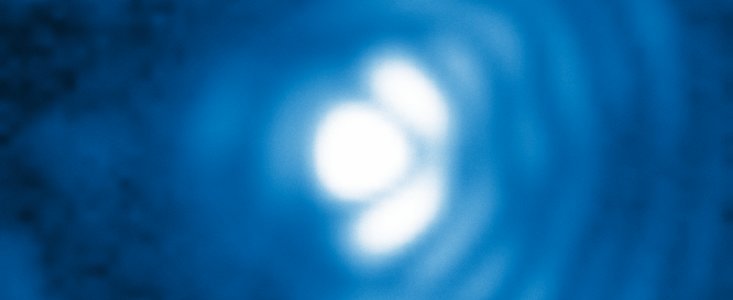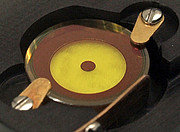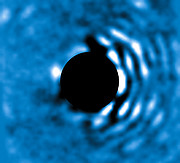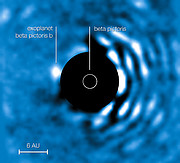Ogłoszenie
New Mode for VLT's NACO to Image Exoplanets
6 lipca 2010
An international collaboration of astronomers has recently commissioned a new observing mode for the NACO adaptive optics instrument attached to ESO’s Very Large Telescope (VLT) on Paranal. The new capability counteracts the effects of diffraction of light very close to a bright star, enabling astronomers to see very faint nearby objects.
The prime example of the kind of objects that can be searched for with the new VLT observing mode, called the Apodising Phase Plate (APP), are Jupiter-like gas giant planets that could be lurking around Sun-like stars in our galaxy. The new mode enables astronomers to search for planets closer to the star than has been previously possible.
As a demonstration of the power of the APP technique, a team led by Matthew Kenworthy, Sascha Quanz, and Michael Meyer have confirmed the recent detection of the giant exoplanet around the star Beta Pictoris (eso1024; led by A.-M. Lagrange, Grenoble), adding precious information on the orbit and nature of the planet.
“We were very excited to see such a clear detection of the Beta Pictoris planet,” says Sascha Quanz, lead author of a paper in preparation describing the detection. “This new ‘coronagraphic’ capability proved itself on the second night of the commissioning run, simultaneously demonstrating its ease of use and the ability to image planets near their host stars.”
“Our ability to confirm the fantastic new results concerning Beta Pictoris was a tremendous boost for the APP effort. We look forward to seeing many astronomers exploiting this new capability on the VLT,” adds co-author and Principal Investigator of the APP Michael Meyer.
Commissioned and tested at the ESO VLT in April 2010, one of the unique properties of the new mode is that it does not require any special alignment with the target star, making it simple to use for other astronomers at the VLT. The theory of this type of coronagraph was developed by Johanan Codona (Steward Observatory, University of Arizona) and initially tested by Kenworthy.
“Many other coronagraphs use two optical components working together to suppress the starlight from a target star,” says Kenworthy. “The APP uses only one optical component, which makes it simple to use for sensitive exoplanet searches very close to the star.”
Its ease of use will enable the detection not only of exoplanets, but of other faint extended structures around young stars and quasars.
Notes
The team includes Matthew Kenworthy (Leiden Observatory), Sascha Quanz and Michael Meyer (ETH Zurich, Institute for Astronomy) Markus Kasper (ESO Garching, Germany), Rainer Lenzen (Max Planck Institute for Astronomy, Heidelberg, Germany), Julien Girard (ESO Santiago, Chile), and Philip Hinz (Steward Observatory, Tucson Arizona, USA).
Kontakt
Sascha P. Quanz and Michael R. Meyer
Swiss Federal Institute of Technology (ETH)
Phone: +41 44 633 28 30, +41 44 633 44 50
Email: quanz@astro.phys.ethz.ch, mmeyer@phys.ethz.ch
Matthew Kenworthy
Sterrewacht Leiden, The Netherlands
Phone: +31(0)71 527 8455
Email: kenworthy@strw.leidenuniv.nl
Markus Kasper
ESO
Garching, Germany
Tel: +49 89 3200 6359
Email: mkasper@eso.org
Henri Boffin
ESO, La Silla, Paranal and E-ELT Press Officer
Garching, Germany
Tel: +49 89 3200 6222
Cell: +49 174 515 43 24
Email: hboffin@eso.org
O ogłoszeniu
| Identyfikator: | ann1037 |
Our use of Cookies
We use cookies that are essential for accessing our websites and using our services. We also use cookies to analyse, measure and improve our websites’ performance, to enable content sharing via social media and to display media content hosted on third-party platforms.
ESO Cookies Policy
The European Organisation for Astronomical Research in the Southern Hemisphere (ESO) is the pre-eminent intergovernmental science and technology organisation in astronomy. It carries out an ambitious programme focused on the design, construction and operation of powerful ground-based observing facilities for astronomy.
This Cookies Policy is intended to provide clarity by outlining the cookies used on the ESO public websites, their functions, the options you have for controlling them, and the ways you can contact us for additional details.
What are cookies?
Cookies are small pieces of data stored on your device by websites you visit. They serve various purposes, such as remembering login credentials and preferences and enhance your browsing experience.
Categories of cookies we use
Essential cookies (always active): These cookies are strictly necessary for the proper functioning of our website. Without these cookies, the website cannot operate correctly, and certain services, such as logging in or accessing secure areas, may not be available; because they are essential for the website’s operation, they cannot be disabled.
Functional Cookies: These cookies enhance your browsing experience by enabling additional features and personalization, such as remembering your preferences and settings. While not strictly necessary for the website to function, they improve usability and convenience; these cookies are only placed if you provide your consent.
Analytics cookies: These cookies collect information about how visitors interact with our website, such as which pages are visited most often and how users navigate the site. This data helps us improve website performance, optimize content, and enhance the user experience; these cookies are only placed if you provide your consent. We use the following analytics cookies.
Matomo Cookies:
This website uses Matomo (formerly Piwik), an open source software which enables the statistical analysis of website visits. Matomo uses cookies (text files) which are saved on your computer and which allow us to analyze how you use our website. The website user information generated by the cookies will only be saved on the servers of our IT Department. We use this information to analyze www.eso.org visits and to prepare reports on website activities. These data will not be disclosed to third parties.
On behalf of ESO, Matomo will use this information for the purpose of evaluating your use of the website, compiling reports on website activity and providing other services relating to website activity and internet usage.
Matomo cookies settings:
Additional Third-party cookies on ESO websites: some of our pages display content from external providers, e.g. YouTube.
Such third-party services are outside of ESO control and may, at any time, change their terms of service, use of cookies, etc.
YouTube: Some videos on the ESO website are embedded from ESO’s official YouTube channel. We have enabled YouTube’s privacy-enhanced mode, meaning that no cookies are set unless the user actively clicks on the video to play it. Additionally, in this mode, YouTube does not store any personally identifiable cookie data for embedded video playbacks. For more details, please refer to YouTube’s embedding videos information page.
Cookies can also be classified based on the following elements.
Regarding the domain, there are:
- First-party cookies, set by the website you are currently visiting. They are stored by the same domain that you are browsing and are used to enhance your experience on that site;
- Third-party cookies, set by a domain other than the one you are currently visiting.
As for their duration, cookies can be:
- Browser-session cookies, which are deleted when the user closes the browser;
- Stored cookies, which stay on the user's device for a predetermined period of time.
How to manage cookies
Cookie settings: You can modify your cookie choices for the ESO webpages at any time by clicking on the link Cookie settings at the bottom of any page.
In your browser: If you wish to delete cookies or instruct your browser to delete or block cookies by default, please visit the help pages of your browser:
Please be aware that if you delete or decline cookies, certain functionalities of our website may be not be available and your browsing experience may be affected.
You can set most browsers to prevent any cookies being placed on your device, but you may then have to manually adjust some preferences every time you visit a site/page. And some services and functionalities may not work properly at all (e.g. profile logging-in, shop check out).
Updates to the ESO Cookies Policy
The ESO Cookies Policy may be subject to future updates, which will be made available on this page.
Additional information
For any queries related to cookies, please contact: pdprATesoDOTorg.
As ESO public webpages are managed by our Department of Communication, your questions will be dealt with the support of the said Department.




